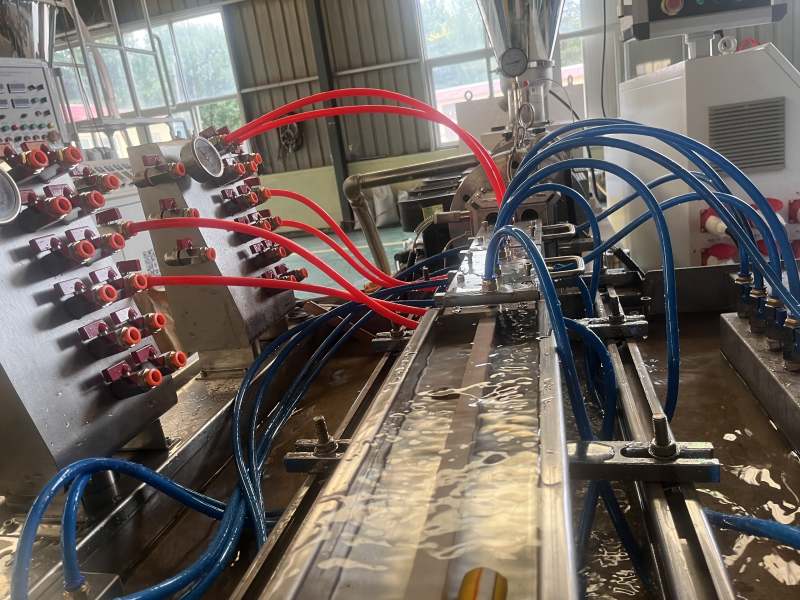Yongte PVC cable trunk extrusion machine is the key equipment for the manufacture of PVC cable. It plasticizes and extrudes PVC raw materials by heating and rotating the screw. Precise control of extrusion shape and size to ensure cable sheath or insulation quality. Widely used in the field of cable production, efficient and stable, is an important guarantee to improve the quality of cable.
PVC cable dry extrusion machine is an important equipment in cable manufacturing industry.
It is composed of a heating device, a screw, a barrel, a head and a mold. When working, the PVC plastic particles are first put into the barrel, the heating device makes it melt, and the screw constantly rotates to push the material. Through the precise design of the head and mold, the PVC cable sheath or insulation is extruded to meet the standard.
The equipment has the advantages of high efficiency, stability and good product quality. It can adapt to the production needs of different specifications of cables, and plays a key role in ensuring the electrical performance and mechanical strength of cables.
First, the PVC plastic particles are added to the hopper. The material enters the barrel under the action of gravity.
There is a heating device inside the barrel, and the temperature inside the barrel is raised to the melting temperature of PVC plastic by electric heating or other heating methods.
The screw rotates under the drive of the motor. Screw structure design is special, there are different pitch and thread depth. In the rotation process, the screw has the effect of pushing forward and stirring and extrusion on the material, so that the PVC plastic is fully heated and gradually plasticized.
The plasticized molten material is pushed by the screw, filtered through the filter screen to remove impurities, and then pushed to the head.
The heads and dies have specific shapes and sizes. The molten material is pressed inside the head and eventually extruded from the mouth of the mold to form a continuous PVC cable sheath or insulation layer.
In the entire extrusion process, temperature, pressure, screw speed and other parameters need to be precisely controlled to ensure that the extruded PVC cable has good quality and dimensional accuracy.
1. Efficient production: continuous and automated production can be achieved, which greatly improves production efficiency and meets the large market demand for PVC cables.
2. Stable product quality: precise temperature control, uniform plasticization and stable extrusion pressure ensure the quality consistency of the cable jacket or insulation layer and reduce the defective rate.
3. Cost saving: Optimized process flow and efficient energy utilization reduce the waste of raw materials and reduce production costs.
4. High flexibility: according to different cable specifications and requirements, quickly replace the mold and adjust the process parameters to adapt to diversified production needs.
5. Easy operation and maintenance: the automation of the production line is high, the operation is simple, and the equipment structure is reasonable, which is convenient for daily maintenance and troubleshooting.
6. Environmental protection and energy saving: The use of advanced energy-saving technology to reduce energy consumption and reduce the impact on the environment.
7. Improve product performance: PVC cable can have good electrical insulation properties, mechanical properties and weather resistance, and extend the service life of the cable.
1. Power industry: used in the production of medium and low voltage power cables used in power transmission and distribution, such as overhead insulated cables, power cable sheaths and insulation layers.
2. Communication field: Manufacturing communication cables, including city communication cables, long-distance communication cables, etc.
3. Construction industry: Provide PVC cables for building wiring, such as wires, socket connections, etc.
4. Industrial control: Production of special control cables for industrial automation equipment and control systems.
5. Household appliances: The production of various household appliances internal connection wire and cable.
6. Rail transit: such as subway, light rail and other rail transit vehicles in the cable.
7. New energy field: cables used to connect components and equipment in new energy generation and energy storage systems such as solar energy and wind energy.




